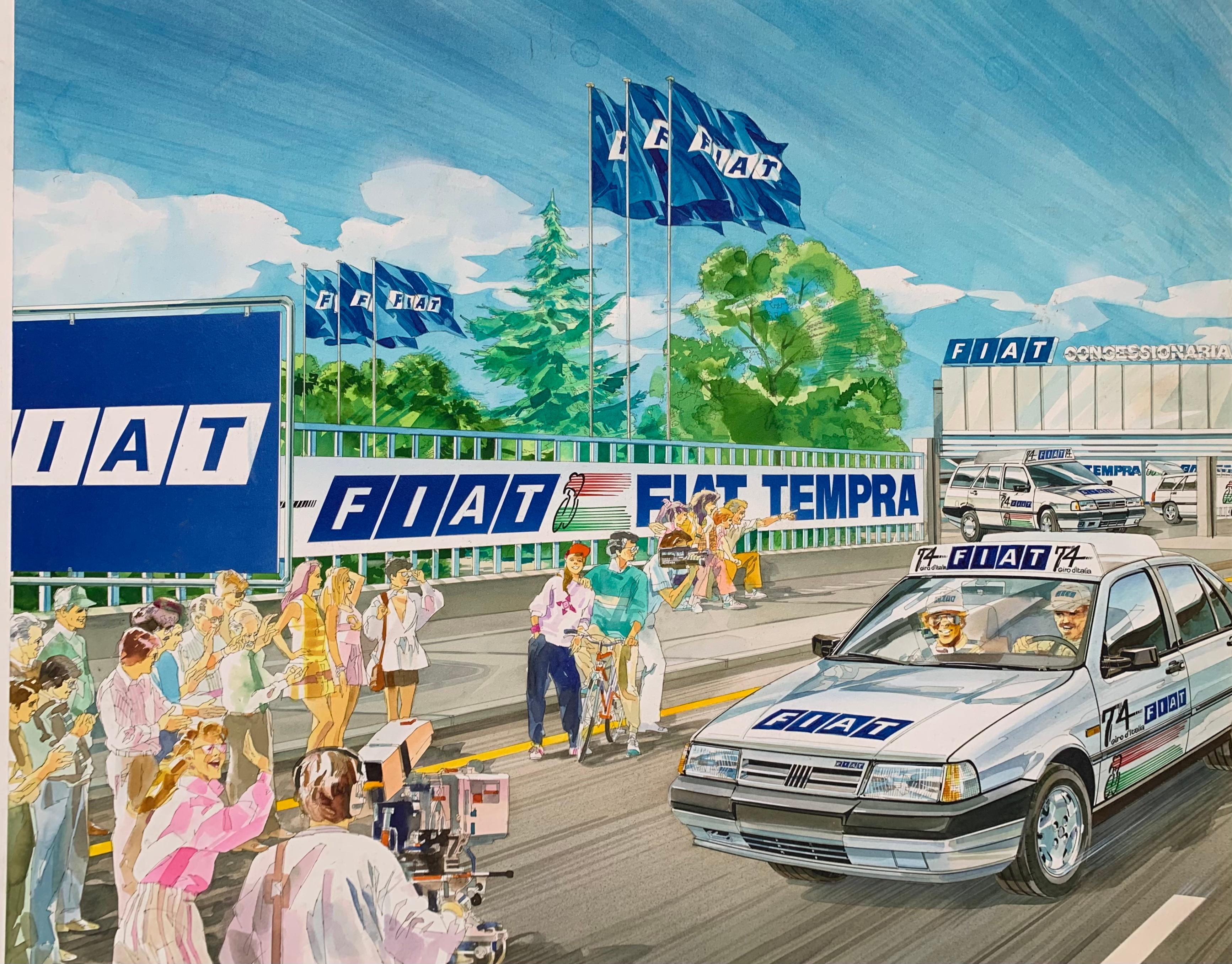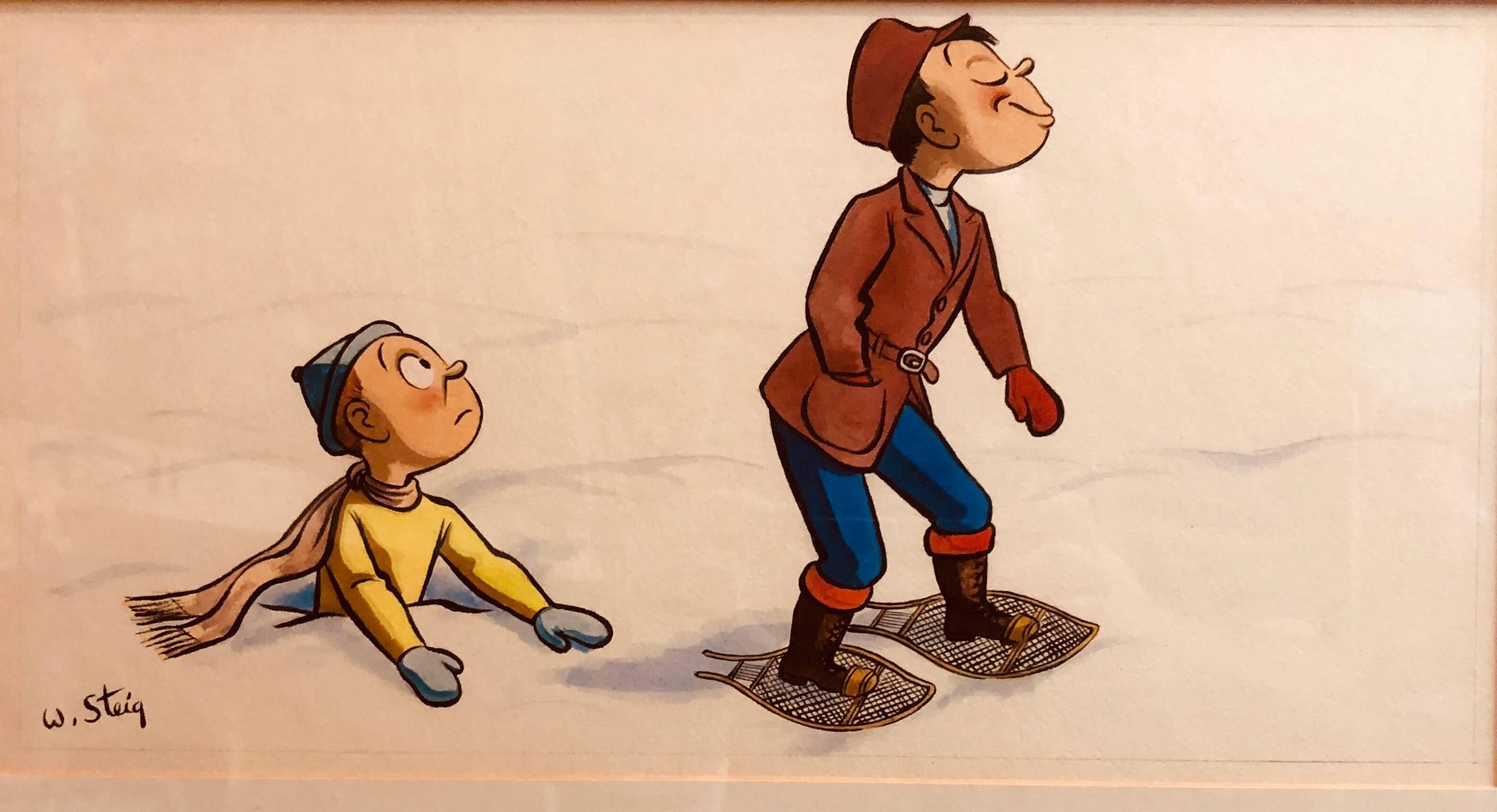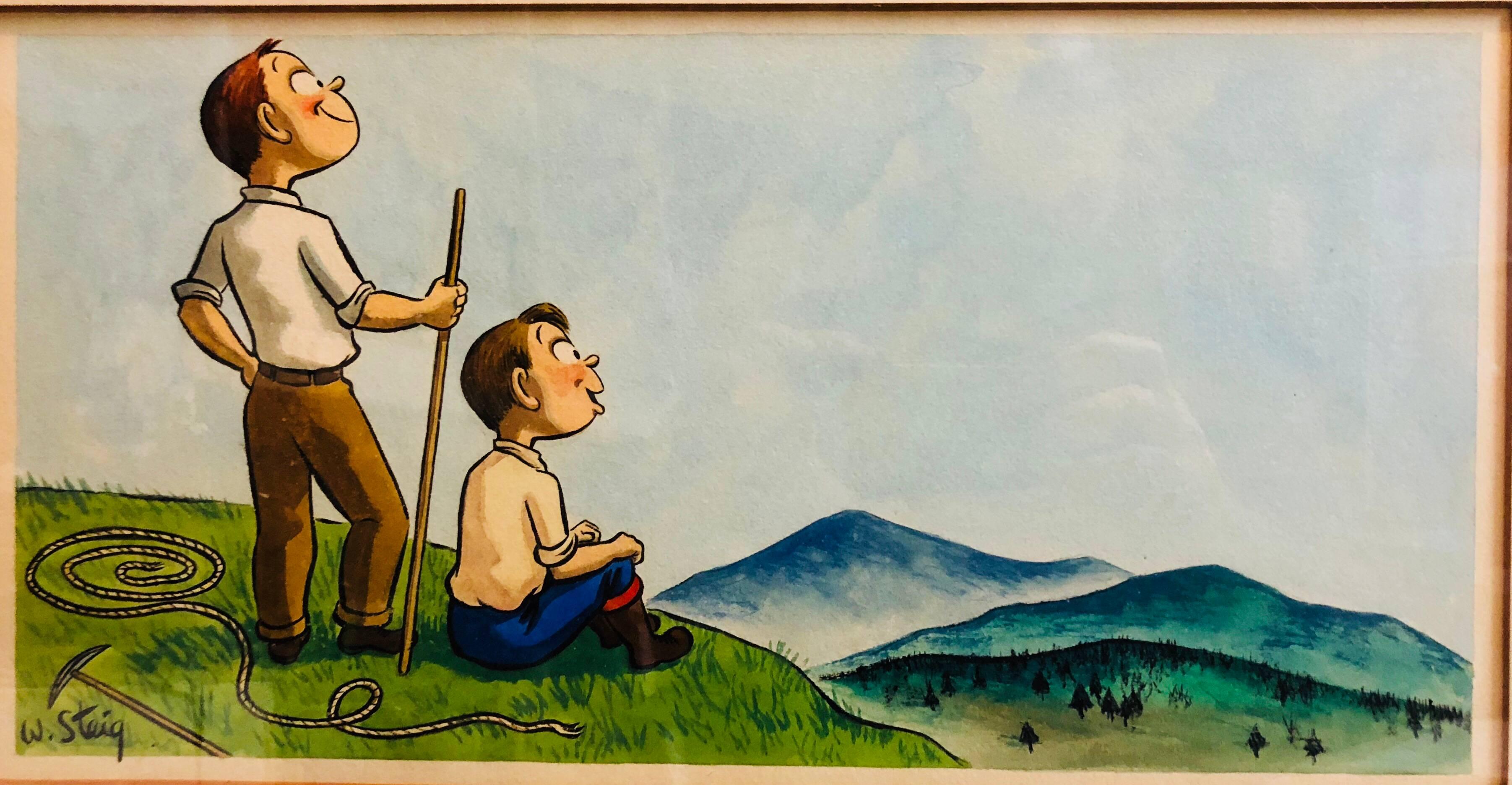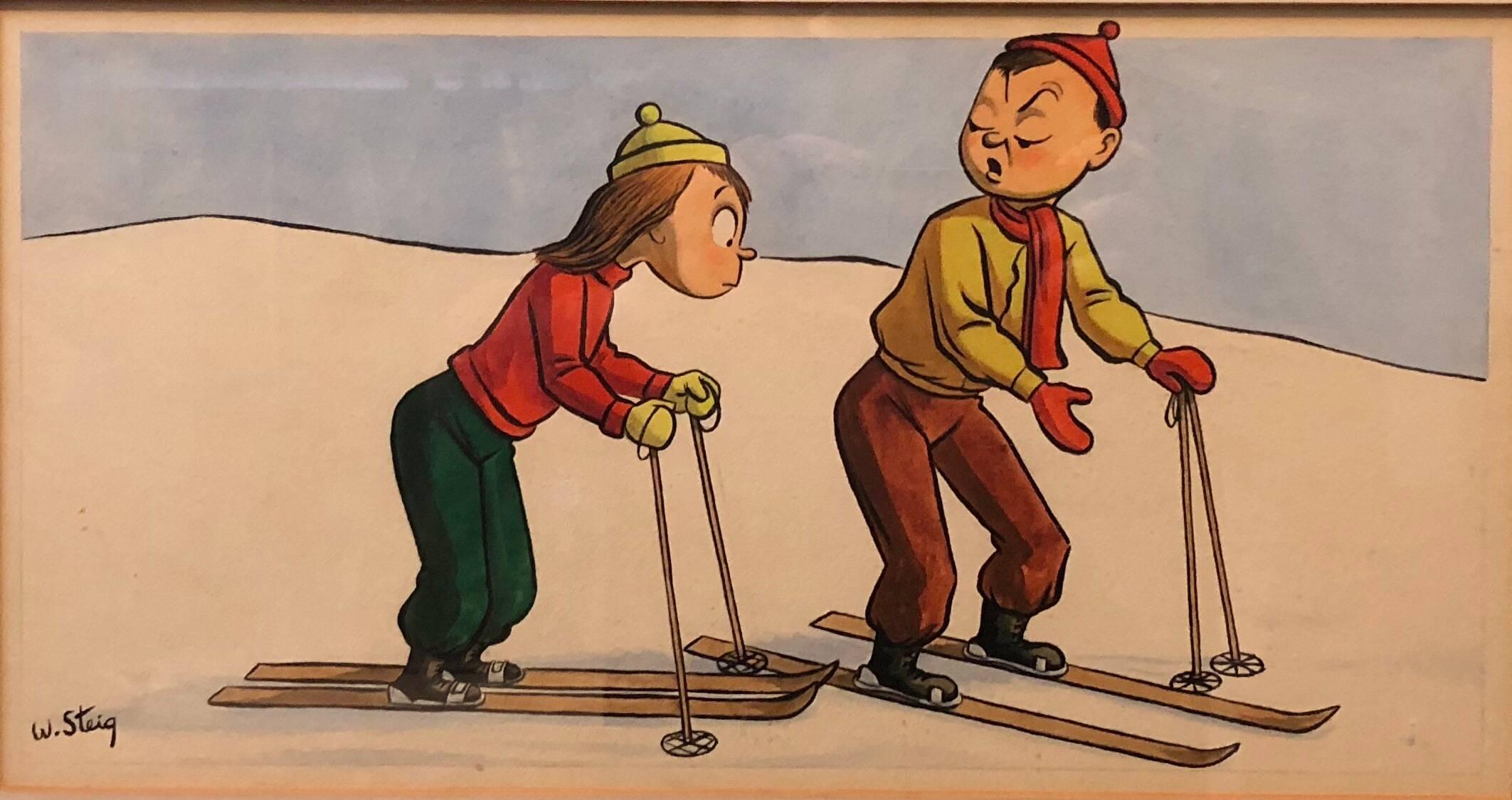Items Similar to Sydney, Australia, from Darling Point
Want more images or videos?
Request additional images or videos from the seller
1 of 11
Brett HilderSydney, Australia, from Darling Point1961
1961
About the Item
A delicate watercolor landscape showing a panoramic view of Australia's capital city looking towards Sydney Harbor Bridge from this desirable eastern suburb.
Signed lower right "Brett Hilder", a listed artist, and dated 1961.
Son of the noted watercolorist, Jesse Hilder, Brett Hilder exhibited widely and with success throughout a long career. He also wrote extensively on navigation and published three books, Navigator in the South Seas (Percival Marshall), The Heritage of JJ Hilder (Ure Smith) and The Voyage of Torres (Univ of Qld Press).
- Creator:Brett Hilder (1911 - 1981, Australian)
- Creation Year:1961
- Dimensions:Height: 14.5 in (36.83 cm)Width: 22 in (55.88 cm)Depth: 0.1 in (2.54 mm)
- Medium:
- Period:
- Condition:age-toning; unframed.
- Gallery Location:Santa Cruz, CA
- Reference Number:1stDibs: LU3441008933
About the Seller
5.0
Platinum Seller
These expertly vetted sellers are 1stDibs' most experienced sellers and are rated highest by our customers.
Established in 1982
1stDibs seller since 2013
629 sales on 1stDibs
Typical response time: 1 hour
- ShippingRetrieving quote...Ships From: Santa Cruz, CA
- Return PolicyA return for this item may be initiated within 3 days of delivery.
More From This SellerView All
- 'The Little Bandit', California Raccoon, National Watercolor SocietyBy Jack BevierLocated in Santa Cruz, CASigned lower right, 'Jack B. Bevier' for Jack Bernard Bevier (American, 1923-1996) and painted circa 1985. Born in Michigan, Bevier was primarily a watercolor painter who specialized in rural country landscapes, seascapes of the Monterey Peninsula, boat and harbor scenes. Jack Bevier was educated in Ann Arbor, Michigan before serving 3 years in the Army Air Corp during World War II. After the war he attended the Art Institute of Chicago where he graduated with honors. After six years of painting and working in the commercial art business in Chicago, Bevier moved to California. He settled in the Salinas area on the Monterey Peninsula in 1956 and operated a gallery in Carmel, California for many years. His works have been exhibited widely and with success including at the National Watercolor Society...Category
1980s Realist Landscape Drawings and Watercolors
MaterialsGouache, Illustration Board
- 'Old Reliable', Early American Modernist, Jalopy, Model T Ford Flatbed TruckLocated in Santa Cruz, CAAn American School watercolor showing an old Ford Model T flatbed truck backed up to a barn in a rural landscape. A well-composed work paint...Category
1920s Modern Landscape Drawings and Watercolors
MaterialsWatercolor, Gouache, Illustration Board
- 'Stonehenge at Sunset', Royal Academy, RSBA, Benezit, Wiltshire, Druid, CelticBy Robert GallonLocated in Santa Cruz, CASigned lower left, 'R. Gallon' for Robert Gallon (English, 1845-1925) and painted circa 1880. This well-listed landscape and seascape painter maintained a studio in St John's Wood, ...Category
Late 19th Century Romantic Landscape Drawings and Watercolors
MaterialsIllustration Board, Watercolor
- 'Spring Flowers', Kansas, Carmel Art Association, Pratt Institute, AIC, ASLBy Charlotte MortonLocated in Santa Cruz, CASigned lower right, 'Charlotte A. Morton' (American, 1885-1974) and painted circa 1955. A sensitive study of various blossoms including geraniums, lupin and catmint. A landscape painter and teacher, Charlotte Augusta Morton graduated from Kansas State College before continuing her education at the Art Institute of Chicago, the Art Students League of New York and the Pratt Institute. After moving to California and attending Stanford University where she received her Masters in Education, Morton taught at San Jose State College before moving to Monterey and joining the Carmel Art...Category
1950s Landscape Drawings and Watercolors
MaterialsWatercolor, Illustration Board, Graphite
- 'Fisherman's Wharf, Monterey', Modernist California Artist, Crocker Art MuseumBy Muriel BackmanLocated in Santa Cruz, CASigned lower right, "M. Backman" for Muriel Backman (American, 1902-1996), titled verso and dated 1955. A vibrant Modernist work by this notable California woman artist who exhibit...Category
1950s Post-Impressionist Landscape Drawings and Watercolors
MaterialsWatercolor, Illustration Board, Graphite
- 'Sunset Landscape with Cottage', Large 19th c. American WatercolorBy W.C.EisenLocated in Santa Cruz, CAA substantial, antique landscape showing a view of a picturesque rustic cottage standing beside a pond at late sunset. An unusually large and atmospheric watercolor with exceptionall...Category
Early 1900s Landscape Drawings and Watercolors
MaterialsPaper, Watercolor, Illustration Board
You May Also Like
- “Waterfall with Birches”Located in Southampton, NYOriginal watercolor of a waterfall with birch trees on illustration board by the well known American artist, William Paskell. Signed lower left. Condi...Category
1920s Post-Impressionist Landscape Drawings and Watercolors
MaterialsWatercolor, Illustration Board
- Advertising Graphic project for FIAT by Marco Silombria. Circa 1980Located in Firenze, ITCar rally. Fiat factory team. Marco Silombria (Savona, 1035- Turin, 2014) Mixed media: drawing, watercolor, pencils on paper, applied to hard support Around 1980. Marco Silombria...Category
1970s Pop Art Landscape Drawings and Watercolors
MaterialsPlastic, Paper, Mixed Media, Watercolor, Illustration Board, Pencil
- Whimsical Fishing Illustration Cartoon 1938 Mt Tremblant Ski Lodge William SteigBy William Steig (b.1907)Located in Surfside, FLLighthearted Illustration of Outdoor Pursuits This one of a fisherman signed "W. Steig" Provenance: from Mrs. Joseph B. Ryan, Commissioned by Joe Ryan for the bar at his ski resort, Mount Tremblant Lodge, in 1938. Mont Tremblant, P.Q., Canada Watercolor and ink on illustration board, sights sizes 8 1/2 x 16 1/2 in., framed. In 1938 Joe Ryan, described as a millionaire from Philadelphia, bushwhacked his way to the summit of Mont Tremblant and was inspired to create a world class ski resort at the site. In 1939 he opened the Mont Tremblant Lodge, which remains part of the Pedestrian Village today. This original illustration is on Whatman Illustration board. the board measures 14 X 22 inches. label from McClees Galleries, Philadelphia, on the frame backing paper. William Steig, 1907 – 2003 was an American cartoonist, sculptor, and, in his later life, an illustrator and writer of children's books. Best known for the picture books Sylvester and the Magic Pebble, Abel's Island, and Doctor De Soto, he was also the creator of Shrek!, which inspired the film series of the same name. He was the U.S. nominee for both of the biennial, international Hans Christian Andersen Awards, as a children's book illustrator in 1982 and a writer in 1988. Steig was born in Brooklyn, New York in 1907, and grew up in the Bronx. His parents were Polish-Jewish immigrants from Austria, both socialists. His father, Joseph Steig, was a house painter, and his mother, Laura Ebel Steig, was a seamstress who encouraged his artistic leanings. As a child, he dabbled in painting and was an avid reader of literature. Among other works, he was said to have been especially fascinated by Pinocchio.He graduated from Townsend Harris High School at 15 but never completed college, though he attended three, spending two years at City College of New York, three years at the National Academy of Design and a mere five days at the Yale School of Fine Arts before dropping out of each. Hailed as the "King of Cartoons" Steig began drawing illustrations and cartoons for The New Yorker in 1930, producing more than 2,600 drawings and 117 covers for the magazine. Steig, later, when he was 61, began writing children's books. In 1968, he wrote his first children's book. He excelled here as well, and his third book, Sylvester and the Magic Pebble (1969), won the Caldecott Medal. He went on to write more than 30 children's books, including the Doctor DeSoto series, and he continued to write into his nineties. Among his other well-known works, the picture book Shrek! (1990) formed the basis for the DreamWorks Animation film Shrek (2001). After the release of Shrek 2 in 2004, Steig became the first sole-creator of an animated movie franchise that went on to generate over $1 billion from theatrical and ancillary markets after only one sequel. Along with Maurice Sendak, Saul Steinberg, Ludwig Bemelmans and Laurent de Brunhofff his is one of those rare cartoonist whose works form part of our collective cultural heritage. In 1984, Steig's film adaptation of Doctor DeSoto directed by Michael Sporn was nominated for the Academy Award for Best Animated Short Film. As one of the most admired cartoonists of all time, Steig spent seven decades drawing for the New Yorker magazine. He touched generations of readers with his tongue–in–cheek pen–and–ink drawings, which often expressed states of mind like shame, embarrassment or anger. Later in life, Steig turned to children's books, working as both a writer and illustrator. Steig's children's books were also wildly popular because of the crazy, complicated language he used—words like lunatic, palsied, sequestration, and cleave. Kids love the sound of those words even if they do not quite understand the meaning. Steig's descriptions were also clever. He once described a beached whale as "breaded with sand." Throughout the course of his career, Steig compiled his cartoons and drawings into books. Some of them were published first in the New Yorker. Others were deemed too dark to be printed there. Most of these collections centered on the cold, dark psychoanalytical truth about relationships. They featured husbands and wives fighting and parents snapping at their kids. His first adult book, Man About Town, was published in 1932, followed by About People, published in 1939, which focused on social outsiders. Sick of Each Other, published in 2000, included a drawing depicting a wife holding her husband at gunpoint, saying, "Say you adore me." According to the Los Angeles Times, fellow New Yorker artist...Category
1930s American Modern Figurative Drawings and Watercolors
MaterialsIndia Ink, Watercolor, Illustration Board
- Whimsical Illustration "Snow" Cartoon, 1938 Mt Tremblant Ski Lodge William SteigBy William Steig (b.1907)Located in Surfside, FLLighthearted Illustration of Outdoor Pursuits This one being cross country Snow Shoes signed "W. Steig" Provenance: from Mrs. Joseph B. Ryan, Commissioned by ...Category
1930s American Modern Figurative Drawings and Watercolors
MaterialsIndia Ink, Watercolor, Illustration Board
- Whimsical Illustration Hiking Cartoon, 1938 Mt Tremblant Ski Lodge William SteigBy William Steig (b.1907)Located in Surfside, FLLighthearted Illustration of Outdoor Pursuits This one being cross country hiking signed "W. Steig" Provenance: from Mrs. Joseph B. Ryan, Commissioned by Joe Ryan for the bar at his ski resort, Mount Tremblant Lodge, in 1938. Mont Tremblant, P.Q., Canada Watercolor and ink on illustration board, sights sizes 8 1/2 x 16 1/2 in., framed. In 1938 Joe Ryan, described as a millionaire from Philadelphia, bushwhacked his way to the summit of Mont Tremblant and was inspired to create a world class ski resort at the site. In 1939 he opened the Mont Tremblant Lodge, which remains part of the Pedestrian Village today. This original illustration is on Whatman Illustration board. the board measures 14 X 22 inches. label from McClees Galleries, Philadelphia, on the frame backing paper. William Steig, 1907 – 2003 was an American cartoonist, sculptor, and, in his later life, an illustrator and writer of children's books. Best known for the picture books Sylvester and the Magic Pebble, Abel's Island, and Doctor De Soto, he was also the creator of Shrek!, which inspired the film series of the same name. He was the U.S. nominee for both of the biennial, international Hans Christian Andersen Awards, as a children's book illustrator in 1982 and a writer in 1988. Steig was born in Brooklyn, New York in 1907, and grew up in the Bronx. His parents were Polish-Jewish immigrants from Austria, both socialists. His father, Joseph Steig, was a house painter, and his mother, Laura Ebel Steig, was a seamstress who encouraged his artistic leanings. As a child, he dabbled in painting and was an avid reader of literature. Among other works, he was said to have been especially fascinated by Pinocchio.He graduated from Townsend Harris High School at 15 but never completed college, though he attended three, spending two years at City College of New York, three years at the National Academy of Design and a mere five days at the Yale School of Fine Arts before dropping out of each. Hailed as the "King of Cartoons" Steig began drawing illustrations and cartoons for The New Yorker in 1930, producing more than 2,600 drawings and 117 covers for the magazine. Steig, later, when he was 61, began writing children's books. In 1968, he wrote his first children's book. He excelled here as well, and his third book, Sylvester and the Magic Pebble (1969), won the Caldecott Medal. He went on to write more than 30 children's books, including the Doctor DeSoto series, and he continued to write into his nineties. Among his other well-known works, the picture book Shrek! (1990) formed the basis for the DreamWorks Animation film Shrek (2001). After the release of Shrek 2 in 2004, Steig became the first sole-creator of an animated movie franchise that went on to generate over $1 billion from theatrical and ancillary markets after only one sequel. Along with Maurice Sendak, Saul Steinberg, Ludwig Bemelmans and Laurent de Brunhofff his is one of those rare cartoonist whose works form part of our collective cultural heritage. In 1984, Steig's film adaptation of Doctor DeSoto directed by Michael Sporn was nominated for the Academy Award for Best Animated Short Film. As one of the most admired cartoonists of all time, Steig spent seven decades drawing for the New Yorker magazine. He touched generations of readers with his tongue–in–cheek pen–and–ink drawings, which often expressed states of mind like shame, embarrassment or anger. Later in life, Steig turned to children's books, working as both a writer and illustrator. Steig's children's books were also wildly popular because of the crazy, complicated language he used—words like lunatic, palsied, sequestration, and cleave. Kids love the sound of those words even if they do not quite understand the meaning. Steig's descriptions were also clever. He once described a beached whale as "breaded with sand." Throughout the course of his career, Steig compiled his cartoons and drawings into books. Some of them were published first in the New Yorker. Others were deemed too dark to be printed there. Most of these collections centered on the cold, dark psychoanalytical truth about relationships. They featured husbands and wives fighting and parents snapping at their kids. His first adult book, Man About Town, was published in 1932, followed by About People, published in 1939, which focused on social outsiders. Sick of Each Other, published in 2000, included a drawing depicting a wife holding her husband at gunpoint, saying, "Say you adore me." According to the Los Angeles Times, fellow New Yorker artist Edward Sorel...Category
1930s Naturalistic Figurative Drawings and Watercolors
MaterialsArchival Ink, Watercolor, Illustration Board
- Whimsical Illustration Skiing Cartoon, 1938 Mt Tremblant Ski Lodge William SteigBy William Steig (b.1907)Located in Surfside, FLLighthearted Illustration of Outdoor Pursuits This one being a Skiing scene, a boy and a girl on skis. signed W. Steig Provenance: from Mrs. Joseph B. Ryan, Commissioned by Joe Ryan for the bar at his ski resort, Mount Tremblant Lodge, in 1938. Mont Tremblant, P.Q., Canada Watercolor and ink on illustration board, sights sizes 8 1/2 x 16 1/2 in., framed. In 1938 Joe Ryan, described as a millionaire from Philadelphia, bushwhacked his way to the summit of Mont Tremblant and was inspired to create a world class ski resort at the site. In 1939 he opened the Mont Tremblant Lodge, which remains part of the Pedestrian Village today. This original illustration is on Whatman Illustration board. the board measures 14 X 22 inches. label from McClees Galleries, Philadelphia, on the frame backing paper. William Steig, 1907 – 2003 was an American cartoonist, sculptor, and, in his later life, an illustrator and writer of children's books. Best known for the picture books Sylvester and the Magic Pebble, Abel's Island, and Doctor De Soto, he was also the creator of Shrek!, which inspired the film series of the same name. He was the U.S. nominee for both of the biennial, international Hans Christian Andersen Awards, as a children's book illustrator in 1982 and a writer in 1988. Steig was born in Brooklyn, New York in 1907, and grew up in the Bronx. His parents were Polish-Jewish immigrants from Austria, both socialists. His father, Joseph Steig, was a house painter, and his mother, Laura Ebel Steig, was a seamstress who encouraged his artistic leanings. As a child, he dabbled in painting and was an avid reader of literature. Among other works, he was said to have been especially fascinated by Pinocchio.He graduated from Townsend Harris High School at 15 but never completed college, though he attended three, spending two years at City College of New York, three years at the National Academy of Design and a mere five days at the Yale School of Fine Arts before dropping out of each. Hailed as the "King of Cartoons" Steig began drawing illustrations and cartoons for The New Yorker in 1930, producing more than 2,600 drawings and 117 covers for the magazine. Steig, later, when he was 61, began writing children's books. In 1968, he wrote his first children's book. He excelled here as well, and his third book, Sylvester and the Magic Pebble (1969), won the Caldecott Medal. He went on to write more than 30 children's books, including the Doctor DeSoto series, and he continued to write into his nineties. Among his other well-known works, the picture book Shrek! (1990) formed the basis for the DreamWorks Animation film Shrek (2001). After the release of Shrek 2 in 2004, Steig became the first sole-creator of an animated movie franchise that went on to generate over $1 billion from theatrical and ancillary markets after only one sequel. Along with Maurice Sendak, Saul Steinberg, Ludwig Bemelmans and Laurent de Brunhofff his is one of those rare cartoonist whose works form part of our collective cultural heritage. In 1984, Steig's film adaptation of Doctor DeSoto directed by Michael Sporn was nominated for the Academy Award for Best Animated Short Film. As one of the most admired cartoonists of all time, Steig spent seven decades drawing for the New Yorker magazine. He touched generations of readers with his tongue–in–cheek pen–and–ink drawings, which often expressed states of mind like shame, embarrassment or anger. Later in life, Steig turned to children's books, working as both a writer and illustrator. Steig's children's books were also wildly popular because of the crazy, complicated language he used—words like lunatic, palsied, sequestration, and cleave. Kids love the sound of those words even if they do not quite understand the meaning. Steig's descriptions were also clever. He once described a beached whale as "breaded with sand." Throughout the course of his career, Steig compiled his cartoons and drawings into books. Some of them were published first in the New Yorker. Others were deemed too dark to be printed there. Most of these collections centered on the cold, dark psychoanalytical truth about relationships. They featured husbands and wives fighting and parents snapping at their kids. His first adult book, Man About Town, was published in 1932, followed by About People, published in 1939, which focused on social outsiders. Sick of Each Other, published in 2000, included a drawing depicting a wife holding her husband at gunpoint, saying, "Say you adore me." According to the Los Angeles Times, fellow New Yorker artist Edward Sorel...Category
1930s Naturalistic Figurative Drawings and Watercolors
MaterialsArchival Ink, Watercolor, Illustration Board
Recently Viewed
View AllMore Ways To Browse
From Australia
Art From Australia
Australia Paintings
Paintings From 1961
Long Point
Landscape Australia
Sydney Australia
Australian Landscape Artist
Retro Long Board
Australian Vintage Signs
Vintage Darling
Darling And Vintage
Retro Signs Australia
Smiths Point
Vintage Navigation
Harbor Bridge Painting
Vintage Navigator
Sydney Harbor





